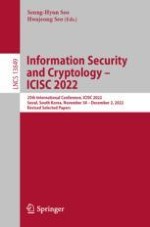2023 | Book
Information Security and Cryptology – ICISC 2022
25th International Conference, ICISC 2022, Seoul, South Korea, November 30 – December 2, 2022, Revised Selected Papers
Editors: Seung-Hyun Seo, Hwajeong Seo
Publisher: Springer Nature Switzerland
Book Series : Lecture Notes in Computer Science
